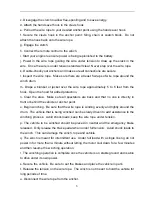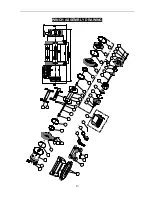
10
When pulling a heavy load, place a blanket or jacket over the wire
rope five or six feet from the hook. In the event of a broken cable it
will dampen the snap back. For additional protection open the
hood of the vehicle as shown in Fig 3.3
For pulls over 70% rated line pull, we recommend the use of the
snatch block/pulley block to double line the wire rope. Fig 3.4
This reduces the load on the winch and the strain on the rope by up
to 50% depending on the included angle.
WARNING -
Never use your winch for overhead hoisting or
for lifting people or moving people.
WINCH WORKING DEMONSTRATION
1. Disengage the clutch by turning the clutch to the
“CLUTCH OUT” position.
2. Grab the cable assembly and pull the cable to the desired length, then attach to
item being pulled.
Caution:
Always leave at least five turns of cable on the drum; Review winch
safety warnings and precautions on page 2
、
3 before continuing.
3. Reengage the clutch by turn the clutch assembly to the
“CLUTCH IN” position,
rarely if ever the clutch is difficult to engage, you should slightly turn the drum by
hand, and then turn the clutch.
4. Insert the switch assembly connector onto the control box.
5. Test-run winch in two directions, each direction for one or two seconds.
6. While standing aside of the tow path, hold and operate the switch assembly
supplied by your choice. To reverse directions. Wait until the motor stops before
reversing directions.
7. When the pulling is complete, remove the switch assembly. From the female
connector of the directional valve and replace the female connectors cover.
Fig 3.3
Fig 3.4
Fig 3.5





























